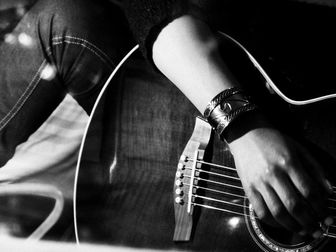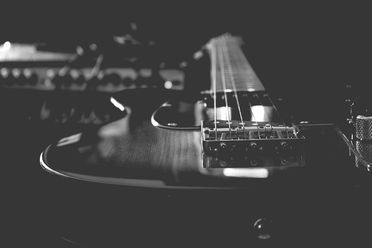Take the Natural Minor scale, it contains the intervals 1, 2, b3, 4, 5, b6, and b7.
Take a Minor 9 chord, it contains the intervals 1, b3, 5, b7, and 9.
Yes, the 2 and the 9 are the same interval/note; it’s just not obvious when you’re thinking from the point of view of scales, and a lot of players don’t tend to see this until it’s pointed out.
b9 – 9 – #9
The 9 comes in three flavors: the b9 (b2), the regular 9 (2), and the #9 (a #2, or a b3). You’ll find the regular 9 in chords such as the maj9 and the dominant 9; for the dominant 9 (1, 3, 5, b7, 9), use the following base pattern:

If you know this pattern, you’ve gotten your way into playing over a dominant 9 chord.

You identify the base pattern according to the chord, then add in the other chord tones. You already know where the 5 is, so load up your looper with an A9 chord and practice with the chord tones. If you’ve been working steadily through this series, you should be finding that you need a hell of a lot fewer notes than you did with scales. Remember: your approach should always be to try to find the intervals you want to play when improvising, NOT learn a pattern then try to play it. This not only sounds lame, but you may as well be playing scales.
How Chords Are Made vs. How Scales Are Made
As I mentioned briefly above, here’s where the confusion starts. Diatonic chords (chords belonging to a key) are made by adding intervals/notes in thirds. For example, our basic dominant 7 chord contains the intervals 1, 3, 5, and b7, but we can add a 9 to get a dominant 9 chord, a 9 and an 11 to get a dominant 11 chord, and even a 13 to get, you guessed it, a dominant 13 chord.
A dominant 13 chord therefore contains the intervals: 1, 3, 5, b7, 9, 11, and 13.
A mixolydian scale is usually written out as: 1, 2, 3, 4, 5, 6, b7.
You’ll see that a mixolydian scale actually contains all the chord tones of a dominant 13 chord if you write it out as follows:
1, 9, 3, 11, 5, 13, b7
What I want you to see here is that scales do perform the same the function as adding chord tones, but the process gets somewhat lost in translation. In ripping a mixolydian scale over a dominant 13 chord, you skate over all the interesting details you hear when you take the time to do it interval by interval and realize what you’re playing.
Back to 9s
Once you realize that the 9 is the same as the 2, and can always be found 2 frets above the root note, you’re ready to modify it.
To get a #9, shift it up a fret, to get a b9, shift it down a fret. In doing this you’ll see that a #9 is the same as a b3 and a b9 is the same as a b2.
The only real technical difference between a 9 and a 2 is the distance from the root. The 2 is right next to the root while the 9 is in the next octave. For practical purposes, they will provide you with the same note.
Task: Load up your looper with an Amaj9 chord and add in the relevant chord tones (1, 3, 5, 7, 9). Here’s your base pattern:

Load up your looper with an Am9 chord and add in the relevant chord tones (1, b3, 5, b7, 9). Here’s your base pattern:

The Hendrix Chord
It creates tension because it really has both thirds in it; remember a #9 gives the same note as a b3, just an octave higher, so you have the major and minor third in the same chord. To improvise over this chord, record an A7#9 chord, take the following base pattern and add in the 5 and #9, which you can locate by shifting the 9 up one fret.

To solo over a 7b9 chord (1, 3, 5, b7, b9), simply shift the 9 down one fret and use the base diagram above. If you can find the 9, you can easily find the b9 and #9 because they’re either side of it.
In Part 6, we’ll look at more upper extensions and how to incorporate them.




Hi Graham, could you please link Part 6 at the bottom of this lesson.
Done, but there should also be a link to it if you scroll a bit further.
Is there a book or blog that has all 8 parts in 1? Thanks!
Right here
I finally bought a looper a few weeks ago, and before I found your website. Sage advice. I wish I had bout one ages ago.